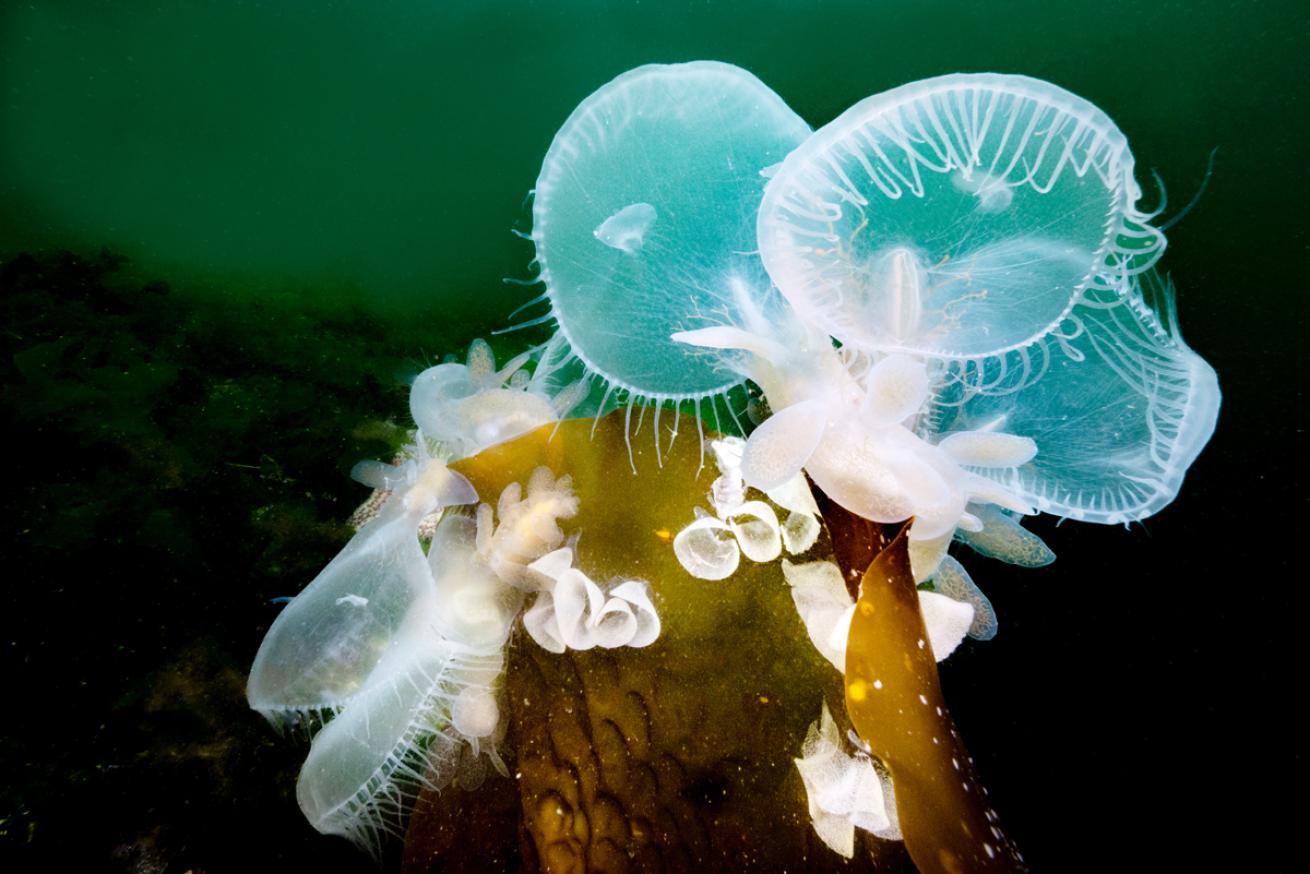Is This The World's Wildest Nudibranch?

Patrick WebsterA pride of lion’s mane nudibranchs (Melibe leonina) in an Alaskan fjord off Baranof Island, photographed while traveling aboard National Geographic Venture with Lindblad Expeditions.
Of all the countless charismatic critters that divers rally around to love and support, nudibranchs enjoy a formidable cult following.
Nudibranchs, named for their “naked gills,” are slugs—molluscan marvels in petite packages that seem to take a particular delight in pushing their anatomy to colorful extremes, making them an absolute treasure to discover and document on any number of dives around the world.
A Melibe nudibranch is one such marvel. It crawls on its belly like snails and other gastropods. OK, that’s about it for the “normal” stuff. “I... uh, um... What exactly am I looking at?” is a common refrain from people who have just had their minds Melibe-fuddled, so I will do my best to explain. But first, what is a nudibranch?
A tad more evocative than their clammy cousins and slightly less theatrical than their cephalopod kin, nudibranchs crawl about the reef in their regal robes largely nonplussed by us bubbling behemoths—fashion icons with a disdain for the paparazzi, comfortable in their own skin and a living embodiment of a “you do you, I’ll do me” mantra that may be the reason why so many of us salty folk have fallen into sluggy worship.
There’s even a website (bowiebranchia.tumblr.com) dedicated to nudibranch colorations that look similar to David Bowie’s outfits throughout his career.
But within the ranks of these already eccentric creatures, there are those innovators that saw what the rest of the crowd was doing and opted to slime their own way through slugdom; those that perceived the limits of their physical reality as peaks to climb instead of obstacles to avoid; those that noticed a crack in the ecological framework as a niche to be filled with a body plan just crazy enough that it could work—a nudibranch’s nudibranch, in other words. Behold: the Melibe.
If you’re a nudibranch photographer, you know that their pretty little “ears”— bunny-esque protrusions that are in fact twin noses known as rhinophores—are key to finding their face. Melibe have ear-like rhinophores too, but you’ll have no issue getting a headshot: Theirs is a billowing visage equipped with an oral hood that inflates into the current like a sail catching the wind to engulf the passing planktonic pantry—or in the case of the Indo-Pacific Melibe fimbriata, a throw- sack that nabs up seafloor critters like an invertebrate game of Hungry Hungry Hippos. Filled with food, the hood closes shut, a gelatinous zipper of tentacle-like cirri interlocking to prevent any spillage of the spoils.
At the base of this beastly yawn is the slug’s throat, leading to a central gut that propagates through the soft body in venous pathways looking like digestive lightning, extending all the way into angelic wings on its back, known as “cerata,” that aid in breathing.
Melibe aren't afraid to ditch quintessential molluscan body parts when needed. Many lack a radula, the rasping tongue that more pedestrian nudibranchs use to lap at bryozoan, hydroid and sponge— noxious fare that often provides the chemical basis for the extravagant colorations and yucky flavors associated with these famously distasteful nudes. Melibe leonina, the lion’s mane nudibranch, instead swallows its food whole.
Then things get weirder: The slug metabolizes its meal into a sweet scent reminiscent of watermelon Jolly Rancher when exposed to air. This compound may deter Meli-would-be predators, and is likely a scent used to attract other lion’s manes to a gregarious batch of slug love.
The Melibe can also be a formidable swimmer—that is, for a slug. Jumping off a kelp frond and writhing its overdone-pasta body back and forth, the nudie airs it out to other sluggy environs for mating opportunities.
Being a hermaphrodite, the slug has no problem finding a match: Both males and females lay little chandeliers of thousands of eggs attached to the substrate, thereby ensuring the next generation of ethereal gelatinous gastropods with Venus’ flytraps for faces will be available to turn the uninitiated into Melibe-lievers by next dive’s end!
In fact, divers from Alaska to California have been seeing new prides of lion’s manes recruiting to the coast this summer. So get out there if you can, or schedule a trip to places where these seasonal slugs Meli-be—they are quite the ocean oddity to Melibe-hold.










